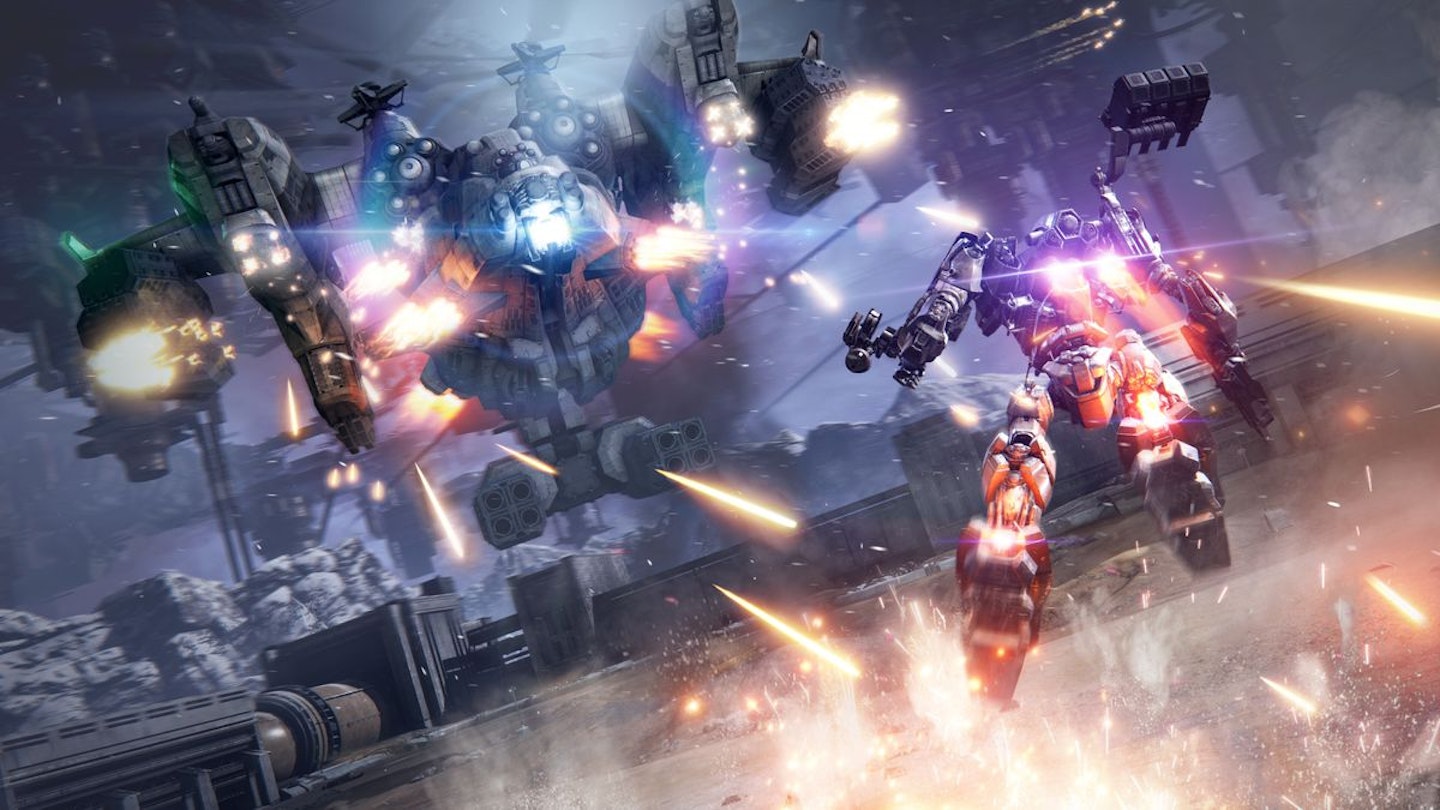Hundred-foot mechanical war machines tearing each other to pieces while laying waste to cities is, it’s fair to say, a significant change of pace from the dark fantasy worlds FromSoftware is synonymous with. Indeed, Fires of Rubicon will come as something of a rude awakening for players who pick it up in the hopes of finding Elden Ring with robots — this is most assuredly not that. It is, rather, a return to FromSoftware’s roots. Since their pioneering of the Soulslike genre, the Japanese developer has made its name with punishingly hard, sprawling RPGs. But before Dark Souls or even Demon’s Souls, there was Armored Core. Dating back to 1997 and the Playstation One, the series was built around players living out their mecha-anime dreams of piloting lumbering mechanical behemoths into battle — a formula From has perfected here, returning to the franchise after 11 years to deliver a glorious resurgence.

Set in a distant future in which mercenaries ply their trade from the cockpits of battle machines known as Armored Cores (or ACs — the game is very fond of its acronyms), Armored Core VI takes us to the world of Rubicon, where a valuable energy resource known as Coral has swiftly become the most sought-after commodity in the galaxy. As warring corporations bicker over the rights to mine it, your silent protagonist (the catchily-monikered C4-621) begins life as a merc, taking on corporate interests while clashing with the RLF (Rubicon Liberation Front) and the PCA (Planetary Closure Administration — think military-grade bailiffs, only with orbital laser batteries instead of bolt cutters).
Disappointingly, the story plays out almost entirely through mission briefings, with narrative taking a clear back-seat to action here. Happily, though, the frenetic third-person gameplay more than picks up the slack. Your AC is quick and highly manoeuvrable despite its gargantuan size, with the ability to ‘skate’ around on jets, quick-boost out of danger and even fly towards your enemies at thunderous speed (for as long as your energy reserves will allow). There is an almost balletic quality to the war machine’s movement as you learn to engage enemy forces both on the ground and in the air. Your AC has four primary weapons — one in each hand and a pair mounted on shoulders — with independent buttons for each, and learning to use all of these in concert, while attacking and evading in three-dimensional space, is an initially daunting task. But learn it you must, and learn it fast, because in keeping with FromSoftware’s pedigree, hard-as-nails boss battles drop in at regular intervals, providing skill checks that won’t let you progress until the challenge is met.

Unlike the Souls games, however, bosses in Armored Core are less about learning and countering attack patterns than they are intricate combat puzzles in need of solving by experimentation with loadout. Everything from your mech’s weapons, to its legs, arms, head, boosters, power core and even targeting computer can be upgraded and customised, new parts bought with the financial rewards gained from mission success. A generous checkpoint system permits you to swap out any of these parts each time you reload, allowing you to switch tactics mid-mission. Do you go full heavy metal with tank tracks and grenade launchers? Take to the skies with a hovering frame and rain fury from above? Or build out an agile metal ninja untouchable by enemy fire? The possibilities for customisation seem endless and finding the precise combination to exploit a given enemy’s weakness is key to any kind of success.
It’s an incredibly deep and richly rewarding system that encourages you to pressure test your AC-building skills in the arena against bot opponents and, eventually, online against other players. Meanwhile, further rewards are unlocked by replaying missions to attain higher grades through taking less damage and using less ammo (the costs for both coming out of your post-mission paycheque, harshly docking the wages of trigger happy pilots). However, such micromanagement comes at a cost and while the individual missions are rarely too challenging, the difficulty spikes, when they come, are so steep you half expect to find Tom Cruise dangling off the top.
The depth and complexity of the game is an absolute delight for those willing to sink the time into mastering it.
The attack helicopter at the end of the tutorial mission feels a particularly harsh gatekeeper to the game itself, reducing us to molten slag at least a dozen times before we learned to embrace our inner Gundam and fly straight at it with a laser sword, instead of attempting to engage from afar. Meanwhile, the end of Act 1 boss — the already infamous Balteus — is a challenge that can feel almost insurmountable when you first encounter it, a crucible of pain that’s daunting even by From’s standards and one that is sure to see many players rage quit before they’ve really had a chance to explore what Fires Of Rubicon has to offer.
Which would be a shame, because the depth and complexity of the game is an absolute delight for those willing to sink the time in to mastering it. Tinkering away in the workshop like a grease-smeared mechanic is a large part of the game’s appeal, each new component offering the potential for fresh builds and unlocking all-new styles of play. The story, which evolves from corporate busy-work to political conflict, is diverting enough, but it’s the precisely calibrated action that pushes Armored Core VI over the top, leaving a hugely rewarding, deeply complex action shooter that taxes your mind as much as it does your trigger fingers.
